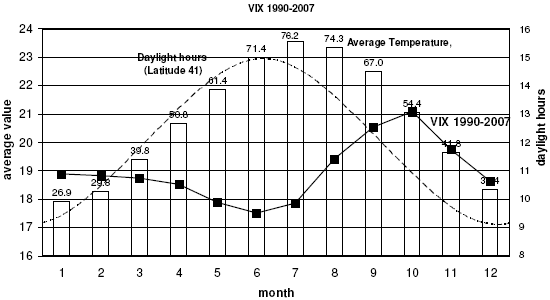Do northern hemisphere seasonal variations impact stock market volatility and return by affecting aggregate investor/trader mood? In their April 2008 paper entitled “Seasonal Affective Disorder (SAD) and Perceived Market Risk”, Guy Kaplanski and Haim Levy test the effect of seasonal environmental factors (daylight hours, temperature and fall season) on perceived market risk as indicated by the Chicago Board Options Exchange Volatility Index (VIX). VIX, also known as the Fear Index, is a measure of the risk perceived by traders of S&P 500 index options. Using VIX and actual volatility data and environmental measurements (for latitude 41 degrees north, Chicago and New York) over the period 1990-2007, they conclude that:
- The Fear Index (VIX) increases significantly during the fall and when the number of daylight hours is relatively small.
- The relationship between temperature and the Fear Index is inconsistent, perhaps because temperatures can vary considerably even for cities with the same number of daylight hours.
- On an annualized basis across the sample period:
- An increase of one hour of daylight boosts average stock market return by 1.35%.
- An increase of ten degrees Fahrenheit in temperature depresses average stock market return by 1.16%.
- The onset of the fall season depresses average stock the rate of stock market return by 1.72%.
- Seasonal environmental factors do not strongly affect actual volatility. In other words, options traders may be able to exploit differences between perceived risk and actual risk based on seasonal factors.
The following figure, taken from the paper, shows the average VIX by calendar month during 1990-2007, ranging from 17.5 in June to 21.1 in October. It also shows the number of daylight hours and the average temperature during each month. In general, VIX tends to decrease as the number of daylight hours increases and average temperature rises. The first and the last quarters of the year, with short days and low temperatures, have relatively high values of VIX. During September and October, VIX peaks in conflict with daylight and temperature trends, indicating that a fall season effect (the “winter blues”) may substantially darken mood and hence elevate perceived risk.

In summary, traders may be able to exploit predictable seasonal changes in implied volatility that derive from the effects of investor mood on perceived risk and not from variations in actual risk.